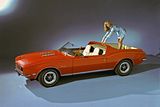We’re certain that if you are reading this, you have seen more than your fair share of Chevrolet El Caminos. Introduced in 1959 in response to Ford’s Ranchero, the first model run only lasted for two years. El Camino production resumed in 1964, and was then based on the Chevelle platform. Then in 1978, it made the switch to GM’s G-body platform. But, how many of you reading this know that a Camaro was tested to be another version of a sportsman’s dream pick up? As soon as the Camaro was released to the public, it was an instant success. Chevrolet wanted to capitalize on that popularity, so different “study cars” were designed and built. The first design-study car was the Waikiki Camaro. This was an uncharacteristically low-budget concept car, built to show the versatility of the new Camaro. Chevrolet simply infused a pair of rectangular headlights into a custom grille, added simulated wood side-trim, and wire wheels. Waikiki badging was also included on each front fender. A second design-study vehicle was the Camaro Caribe. The Caribe is often referred to online as the XP-14 project, but a contact at GM tells us that this designation is incorrect. Our contact also informs us that they were unable to locate an official number designation for the Caribe, but during the time frame of this car’s study, the designations would have been somewhere in the 700 or 800 number range. An official GM memo says that the car was to be built for the Rod and Custom show being held at the Toledo, Ohio, Sports Arena from March 7 through 9, 1968. The car does have large side marker lights, so it was probably based on a 1968 body. That being said, the grille is not visible, so that leads us to believe it might be a grill design intended for an upcoming 1969 model. The study revolved around building a “dream pickup,” so the back portion of the car/truck featured a 5-foot long pickup bed. Teak wood planks covered the floor — and four storage wells, and the inside walls of the bed were made of vinyl. We couldn’t locate much about the interior of the car, except that it was covered in Palomino- and Ivory-colored vinyl with wood accents, and black carpeting. That leads us to believe that it was mostly stock. However, and internal memo states there was a custom-designed console featuring cup holders and a hot beverage dispenser. All sportsmen need their cup of joe before the morning gets underway, so why not pour it in your lap while you drive? Anyway, with the roof, rear passenger and trunk area eliminated, a Targa-style overhead wind deflector was incorporated into the body, and a custom windshield and A-pillars were utilized. Since the hood features Super Sport louvers, and the internal memo we saw states that there is a 396 cubic-inch big-block under that hood, we can only surmise that the Caribe began life as a Super Sport Camaro. The big-block is connected to a four-speed transmission, and the 15-inch aluminum wheels featured brushed-aluminum inserts, and were wrapped with specially-marked Goodyear Wide Oval tires. Aspects not visible in the image are the jet-type front air intake openings filled with high-intensity lights. |
|





